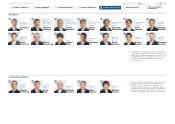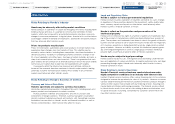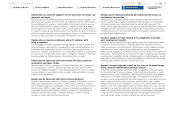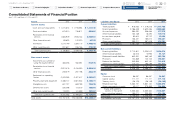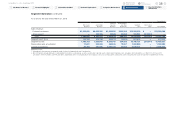Honda 2015 Annual Report Download - page 30
Download and view the complete annual report
Please find page 30 of the 2015 Honda annual report below. You can navigate through the pages in the report by either clicking on the pages listed below, or by using the keyword search tool below to find specific information within the annual report.
In Motorcycle business, we made capital expenditures of ¥68,171 million in the
fiscal year ended March 31, 2015. Funds were allocated to the introduction of new
models, as well as the improvement, streamlining and modernization of production
facilities, and improvement of sales and R&D facilities.
In Automobile business, we made capital expenditures of ¥573,312 million in
the fiscal year ended March 31, 2015. Funds were allocated to the introduction of
new models, as well as the improvement, streamlining and modernization of pro-
duction facilities, and improvement of sales and R&D facilities.
In Financial services business, capital expenditures excluding equipment on
operating leases amounted to ¥432 million in the fiscal year ended March 31,
2015, while capital expenditures for equipment on operating leases were
¥1,681,178 million. Capital expenditures in Power products and other businesses
in the fiscal year ended March 31, 2015, totaling ¥11,896 million, were deployed
to upgrade, streamline, and modernize manufacturing facilities for power prod-
ucts, and to improve R&D facilities for power products.
Liquidity and Capital Resources
Overview of Capital Requirements, Sources and Uses
The policy of Honda is to support its business activities by maintaining sufficient
capital resources, a sufficient level of liquidity and a sound balance sheet.
Honda’s main business is the manufacturing and sale of motorcycles, automo-
biles and power products. To support this business, Honda also funds financial
programs for customers and dealers.
Honda requires working capital mainly to purchase parts and raw materials
required for production, as well as to maintain inventory of finished products and
cover receivables from dealers and for providing financial services. Honda also
requires funds for capital expenditures, mainly to introduce new models, upgrade,
rationalize and renew production facilities, as well as to expand and reinforce sales
and R&D facilities.
Honda meets its working capital requirements primarily through cash generated
by operations and bank loans. Honda believes that its working capital is sufficient
for the Company’s present requirements. The year-end balance of liabilities associ-
ated with the Company and its subsidiaries’ funding for non-Financial services
businesses was ¥592.6 billion as of March 31, 2015. In addition, the Company’s
finance subsidiaries fund financial programs for customers and dealers primarily
from medium-term notes, bank loans, securitization of finance receivables,
commercial paper and corporate bonds. The year-end balance of liabilities associ-
ated with these finance subsidiaries’ funding for Financial services business was
¥6,649.8 billion as of March 31, 2015.
There are no material seasonal variations in Honda’s borrowing requirements.
Liquidity
The ¥1,471.7 billion in cash and cash equivalents as of March 31, 2015 is mainly
denominated in U.S. dollars and in Japanese yen, with the remainder denominated
in other currencies.
Honda’s cash and cash equivalents as of March 31, 2015 corresponds to
approximately 1.3 months of sales revenue, and Honda believes it has sufficient
liquidity for its business operations.
At the same time, Honda is aware of the possibility that various factors, such
as recession-induced market contraction and financial and foreign exchange
market volatility, may adversely affect liquidity. For this reason, finance subsidiaries
that carry total short-term borrowings of ¥1,690.9 billion have committed lines of
credit equivalent to ¥1,166.5 billion that serve as alternative liquidity for the com-
mercial paper issued regularly to replace debt. Honda believes it currently has
sufficient credit limits, extended by prominent international banks, as of the date of
the filing of Honda’s Form 20-F.
Honda’s financing liabilities as of March 31, 2015 are mainly denominated in U.S.
dollars, with the remainder denominated in Japanese yen and in other currencies.
Honda’s short- and long-term debt securities are rated by credit rating agen-
cies, such as Moody’s Investors Service, Inc., Standard & Poor’s Rating Services,
and Rating and Investment Information, Inc. The following table shows the ratings
of Honda’s unsecured debt securities by Moody’s, Standard & Poor’s and Rating
and Investment Information as of March 31, 2015.
Credit ratings for
Short-term
unsecured
debt securities
Long-term
unsecured
debt securities
Moody’s Investors Service P-1 A1
Standard & Poor’s Rating Services A-1 A+
Rating and Investment Information a-1+ AA
The above ratings are based on information provided by Honda and other
information deemed credible by the rating agencies. They are also based on the
agencies’ assessment of credit risk associated with designated securities issued
by Honda. Each rating agency may use different standards for calculating Honda’s
credit rating, and also makes its own assessment. Ratings can be revised or
nullified by agencies at any time. These ratings are not meant to serve as a
recommendation for trading in or holding Honda’s unsecured debt securities.
Honda Motor Co., Ltd. Annual Report 2015 29
6 Financial Section
1 The Power of Dreams
2 Financial Highlights
3 To Our Shareholders
4 Review of Operations
5 Corporate Governance
7
Investor Relations
Information
Return to last
page opened
Go to
contents page





